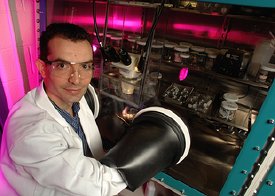Mar 4 2008
Svilen Bobev, assistant professor of chemistry and biochemistry, has received the National Science Foundation's prestigious Faculty Early Career Development Award.
 Svilen Bobev, assistant professor of chemistry and biochemistry, works with compounds containing rare-earth metals in his lab at the University of Delaware. The metals and their compounds are handled inside an argon-filled glove box, which is used to protect the materials from decomposing.
Svilen Bobev, assistant professor of chemistry and biochemistry, works with compounds containing rare-earth metals in his lab at the University of Delaware. The metals and their compounds are handled inside an argon-filled glove box, which is used to protect the materials from decomposing.
The highly competitive funding award, designed to support the integrated research and educational activities of faculty early in their careers, is bestowed on those scientists and engineers deemed most likely to become the academic leaders of the 21st century. Fewer than 20 percent of the proposals submitted to the annual competition are funded.
Bobev will receive $530,000 over the next five years for his research and education project focusing on the synthesis, structural characterization and measurement of the properties of novel compounds formed from the rare earth metals and selected semi-metallic elements, including silicon, germanium and tin.
The rare earth metals are relatively less known than other elements and include the Lanthanide series, found near the bottom of the periodic table. They aren't as rare as once thought. In fact, they are commonly used in industrial catalysts and high-performance magnets in switches and motors.
However, what scientists don't know enough about yet, in Bobev's estimation, are the fundamental characteristics of novel compounds made when the rare earth metals and semi-metallic elements are combined and how the atomic interactions give rise to specific properties.
For Bobev, it's all about getting down to the basics.
“Magnetism and electromagnetism have a hand somewhere in making practically every electronic device work. As a result, magnetic materials have implications that stretch far beyond magnetism and into superconductivity, and have become a matter of great economic importance. Still surprisingly little is known about the basic principles which make magnetic and superconducting materials behave as such,” he notes.
The recent discovery in a single family of gadolinium alloys of giant magnetocaloric effects, which are the basis of cooling technologies for refrigeration, and colossal magnetoresistance, a phenomenon essential for storing vast amounts of data on computer hard drives, emphasize how many challenges and opportunities still lie ahead to deepen our understanding of the chemistry and physics of these ostensibly simple substances, according to Bobev.
“Thus, from an academic prospective, one can recognize the value of the systematic analysis of the fundamental characteristics of any type of old or new compounds--this is what will give us new, valuable insights into the principles governing the structures and properties of such materials,” Bobev notes.
Bobev and his group will develop the synthetic chemistry of the new compounds using state-of-the art techniques available at UD. The group will then analyze the crystal chemistry of the compounds and their properties using powder and single-crystal X-ray diffraction, scanning electron diffraction, and magnetometry. A portion of the experiments is expected to be conducted at the U.S. Department of Energy's Los Alamos and Argonne National Laboratories. Ultimately, the study's findings may aid scientists in “tuning” compounds for specific applications, he says.
Integrated with the research will be new lecture course modules on solid-state chemistry for UD graduate and undergraduate students and laboratory experiments focusing on advanced characterization techniques for “hard materials.”
“Such research experience in solid-state chemistry will provide excellent opportunities for the students to become aware of synthetic and analytical tools that are not available in any of the undergraduate teaching labs,” Bobev says.
Bobev received his master's degree in physical chemistry from the University of Sofia in Bulgaria and his doctorate in inorganic/solid-state chemistry from the University of Notre Dame. He was a postdoctoral fellow at the Los Alamos National Laboratory before joining the UD faculty in September 2004.
A native of Bulgaria, Bobev says he knew when he was 8 years old that he wanted to be a scientist. He was inspired when the first Bulgarian was sent into space aboard the Russian Space Agency's Soyuz-33 spacecraft in 1979. In high school, he says he liked chemistry, physics and computer science and had a hard time choosing a favorite.
Today, he is cutting across the traditional boundaries of these disciplines to help advance the field of solid-state chemistry and materials science.
“It's great to have received this award,” Bobev says. “It's not just recognition for me, but also my students and coworkers. I'd like to extend my thanks to all of them for their hard work.”